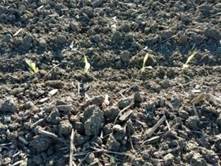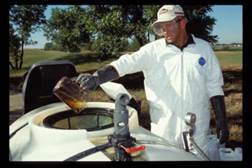Good evening,
Another week has passed and our Hardin County online rainfall reporters (www.cocorahs.org) have collected an average of 1.55 more inches of rain. The recurring rains have made it difficult to finish up planting and replanting corn and soybeans. Some first cuttings of hay have also been delayed as a result of the weather. The weather has been good for the wheat crop. Wheat is now flowering in parts of northern Ohio and will continue to flower over the next week or so. According to the Fusarium Head Blight forecasting system (http://www.wheatscab.psu.edu/), the risk for head scab is low in central and northern Ohio for fields flowering at this time. Although it has rained over the last 2-4 days in parts of the flowering regions, conditions were relatively cool and dry last week, which likely reduced the risk of the head scab fungus infecting the wheat spikes. To read more about wheat diseases, see the attached article. Armyworm adult moth catches this past week in the county were down to one moth per trap, while black cutworm moth captures were at zero.
There has been a lot going on from a farm management standpoint. CAUV changes are being considered in both the House budget bill and in the Senate. Ohio Farm management budgets for corn, soybean, and wheat are showing low to negative returns in 2017. This is also the year for the U.S. Census of Agriculture, so farmers will be encouraged to participate even if they are not selected to participate. These topics as well as others are included in the attached May edition of the Ohio Ag Manager. I have also attached a copy of an article written by Hardin County Master Gardener Volunteer Barb Snyder regarding patching lawns. Although this is best done in early spring or mid-August to mid-September, the information provided is useful if you have areas of your lawn that need attention.
Upcoming local activities include Dairy Feeder Weigh-in and tagging tomorrow (5/27) morning from 8:00-10:30 am at the fairgrounds. Ag Council will be meeting on Friday, June 2 starting at 7:00 am at Henry???s Restaurant. If you have yet to register your children or grandchildren for the June 3 Children???s Day at the Friendship Gardens, I have attached a flyer with more information about that event. Other than that, I hope you have a restful Memorial Day weekend. If you are not busy working in the fields, I have included some agronomy articles below for you to read if interested.
Mark
CORN REPLANT DECISIONS – SOME TIPS TO CONSIDER – Peter Thomison
Farmers confronted with poor stands due to excessive soil moisture, freezing temperatures and frosts, fungal seed decay and seedling rots, soil crusting, as well as other problems that affect corn stands, may be considering replanting their fields. Most corn that’s been planted has yet to emerge or develop much beyond the VE or V2 stage. According to the NASS (https://www.nass.usda.gov/Statistics_by_State/Ohio/Publications/Crop_Progress_&_Condition/index.php ) as of Sunday May 14, 49 percent of Ohio’s corn crop was planted – only 3 percent more than the previous week and 7 percent below the five year average. Only 24% of the crop has emerged.
Replant decisions in corn should be based on strong evidence that the returns to replanting will not only cover replant costs but also net enough to make it worth the effort. Don’t make a final assessment on the extent of damage and stand loss too quickly. Go to https://agcrops.osu.edu/newsletter/corn-newsletter/2017-13/corn-replant-decisions-–-some-tips-consider to read more.
REPLANTING FAILED CORN STANDS – HERBICIDE CONSIDERATIONS – Mark Loux
Replanting a corn field due to weather-related stand problems usually involves killing the first planting, which otherwise really just turns into a weed. A recent article by Dr. Aaron Hager in the U. of Illinois newsletter, “The Bulletin – pest management and crop development information for Illinois”, summarizes this and other herbicide issues for corn replant situations (http://bulletin.ipm.illinois.edu/?p=3874). Bottom line – the only methods to ensure complete control of the first stand of glyphosate-resistant corn are tillage or application of Select Max. Use of Select Max must be followed by a wait of six days before replanting corn, to avoid risk of herbicide injury. Gramoxone and glufosinate (assuming it’s not LibertyLink corn) can have substantial activity on the first stand of corn, but usually do not completely control it. These herbicides are most effective when applied with atrazine or metribuzin, and also when corn is tall enough that the growing point is out of the ground.
The wetter than normal pattern will likely continue into the first half of June now. Weather models have been trending wetter and that is important to note. The risk is increasing toward the wetter side the next 30-days. This applies to much of the corn belt as well not just Ohio. The outlook for the rest of May is for cooler and wetter than normal. It appears we have a rain event this week later Wednesday into part of Thursday then again for the weekend. Each event will average a half inch to inch but there will be variability from 0.25 inches to 1.5 inches. Even next week there could be another system about the middle of next week. It does not appear we will have a five day dry period for hay crops anytime in the next two weeks. To read more about the weather forecast, go to https://agcrops.osu.edu/newsletter/corn-newsletter/2017-14/ohio-applicator-forecast-and-weather-update.
Hats off to those who got their first cutting made during the nice weather earlier, but some of us missed it! Now we have more rain in the forecast about every three days and very wet soils from the heavy rains this past weekend across much of Ohio. While we are eager to get that first cutting made, haste will make waste if we drive on hay stands before the soils are firm enough to support the equipment. When we run hay equipment on soft soils, the wheel compaction damage to plant crowns will be like a plague for the remaining life of the stand. It will lead to lower forage yield, weed invasion, and frustrating attempts to “fill-in” the damaged stand, and ultimately a premature termination of the stand. To finish reading this article, go to https://agcrops.osu.edu/newsletter/corn-newsletter/2017-14/did-you-miss-hay-making-window.
The Soybean and Small Grain Crop Production Lab is pleased to present the first edition of the Ohio Soybean and Wheat Research Report: https://stepupsoy.osu.edu/sites/hcs-soy/files/Soybean%20and%20Wheat%20Trials%202016%203.pdf. This publication contains the final reports of soybean and wheat research trials conducted between 2012-2015 including high-input soybean production, soybean planting date x starter fertilizer, and wide-row wheat production. All research findings were originally published in peer-reviewed journals. Here, we present our research findings of our most recently published research in a concise manner. For other useful soybean and wheat resources, see our recently updated website at: stepupsoy.osu.edu and follow us on Twitter @stepupsoy.
Agriculture and Natural Resources Educator
OSU Extension Hardin County
1021 W. Lima Street, Suite 103, Kenton, OH 43326
419-674-2297 Office




















